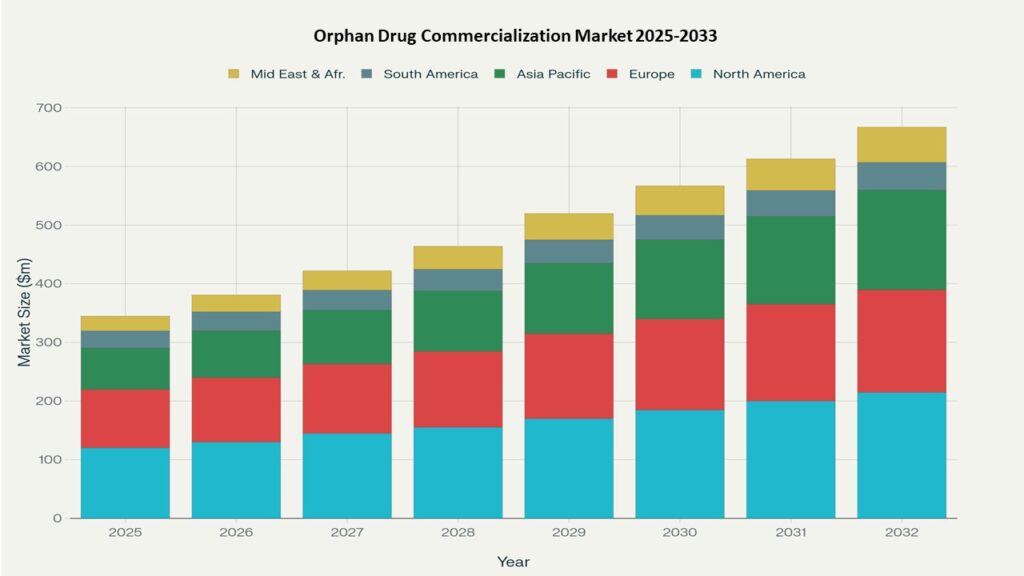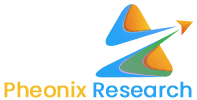Orphan Drug Commercialization Market 2025-2033
Overview
The Orphan Drug Commercialization Market is experiencing robust growth, with global revenues projected to rise from approximately USD 190 billion in 2024 to over USD 528 billion by 2033, reflecting a CAGR of 12%. This market is primarily driven by a surge in rare disease diagnoses, substantial R&D investments, and supportive government incentives such as market exclusivity, tax credits, and expedited FDA approvals.

North America, especially the United States, currently dominates the sector, propelled by a favorable regulatory landscape and rising patient needs. Oncology remains the largest therapeutic segment, fueled by ongoing introductions of cancer-focused orphan therapies. Despite over 500 orphan drugs approved, significant unmet medical needs persist for rare diseases globally. Ongoing advancements in gene therapies and precision medicine, alongside premium pricing models and increasing awareness, are expected to further accelerate market expansion in the coming years.
Key Drivers of Market Growth
- Supportive regulatory frameworks such as the U.S. Orphan Drug Act and various global incentives provide market exclusivity, tax credits, and expedited approvals, encouraging investment and early entry by pharmaceutical companies.
- Rising prevalence and diagnosis of rare diseases—nearly 10,000 identified in the U.S. alone—is expanding the target patient population for orphan drug commercialization.
- Technological advancements in genomics, gene therapy, and personalized medicine have enabled identification and treatment of previously unaddressed rare diseases, creating new opportunities for drug development.
- Increased pharmaceutical and biotechnology investments in rare disease research and development are driving pipeline growth and faster commercialization, especially for biologics and targeted therapies.
- Growing patient advocacy and awareness initiatives are boosting demand for novel treatments and supporting improved market access and reimbursement for orphan drugs.
- Attractive financial incentives and premium pricing models, supported by high unmet clinical needs and limited therapeutic alternatives, contribute to strong revenue potential and sustained market entry.
Market Segmentation
The Orphan Drug Commercialization Market is segmented by:
- Product Type: Biological drugs and non-biological drugs
- Disease Type: Oncology, hematology, neurology, cardiovascular, and others
- Therapy Area: Neuromuscular, respiratory, metabolic, and others
- Distribution Channel: Hospital pharmacies, retail pharmacies, and online pharmacies
North America currently dominates the market due to substantial expenditure and a strong presence of major players, while Asia Pacific is expected to be the fastest-growing region. Oncology-related orphan drugs form the largest therapeutic segment, driven by ongoing innovation and high unmet clinical needs.
Region-Level Insights
- North America: Largest market, supported by favorable regulatory incentives (market exclusivity, tax credits) and robust R&D pipelines.
- Europe: Second-largest market, benefiting from harmonized regulations and national orphan drug frameworks, with key markets in the UK, Germany, and France.
- Asia Pacific: Fastest-growing region, driven by increased healthcare investment, rising awareness, and growing pharmaceutical infrastructure, particularly in China, Japan, and India.
- Latin America & Middle East & Africa: Smaller but emerging markets, supported by improving diagnostics and healthcare access.
Leading Companies in the Market
The market is dominated by major pharmaceutical and biotech companies, including:
- Johnson & Johnson
- AstraZeneca
- Roche
- Novartis
- Vertex Pharmaceuticals
- Sanofi
- Amgen
- Merck & Co.
- Bristol-Myers Squibb
- Pfizer
Bristol-Myers Squibb and Roche have leading oncology-focused orphan drug portfolios. U.S.-based firms like Pfizer, Regeneron, and AbbVie continue to leverage strong pipelines for both cancer and rare diseases.
Strategic Intelligence and AI-Backed Insights
The orphan drug commercialization market is projected to exceed USD 610 billion by 2034, underpinned by regulatory incentives, rising rare disease prevalence, and sustained R&D investments.
AI-powered intelligence is transforming the sector by:
- Identifying rare disease clusters
- Accelerating target discovery and clinical trial optimization
- Forecasting regulatory approvals and regional demand shifts
These data-driven insights enable companies to maximize ROI, improve patient identification, and launch therapies faster. Expansion of gene and cell therapies, supported by premium pricing and favorable reimbursement, is expected to intensify competition and enhance growth opportunities.
Forecast Snapshot: 2025–2033
| Metric | Value |
| 2025 Market Size | USD 215 billion |
| 2033 Market Size | USD 528 billion |
| CAGR (2025–2033) | 12% |
| Largest Region (2025) | North America (41% share) |
| Fastest Growing Region | Asia Pacific (CAGR 14%) |
| Leading Therapeutic Area | Oncology (approx. 35% share) |
| Approved Orphan Drugs (2025) | 550+ |
Why the Global Market Remains Critical
The global orphan drug commercialization market addresses over 7,000 rare diseases affecting millions of patients worldwide. Favorable policies (tax credits, exclusivity, accelerated approvals) enable sustained investment despite small patient populations.
Global growth ensures:
- Broader access to treatments for underserved patients
- Development of advanced modalities (gene & cell therapies)
- Harmonized reimbursement and regulatory practices
This market remains a cornerstone of precision medicine, shaping healthcare delivery and driving biotech innovation worldwide.
Final Takeaway
The orphan drug commercialization market is expected to maintain a 12% CAGR through 2033, surpassing USD 528 billion in value. While North America and Europe continue to lead, Asia Pacific will drive incremental growth.
Opportunities are expanding through gene therapy breakthroughs, targeted biologics, and AI-driven commercialization strategies. Stakeholders that invest in innovative R&D, strengthen patient advocacy collaborations, and optimize regional pricing strategies will capture the greatest share in this rapidly evolving sector.
